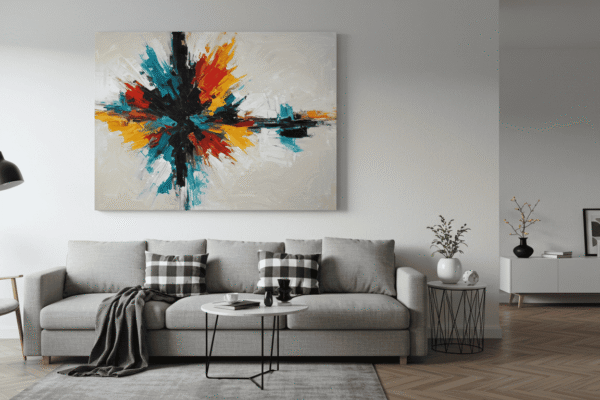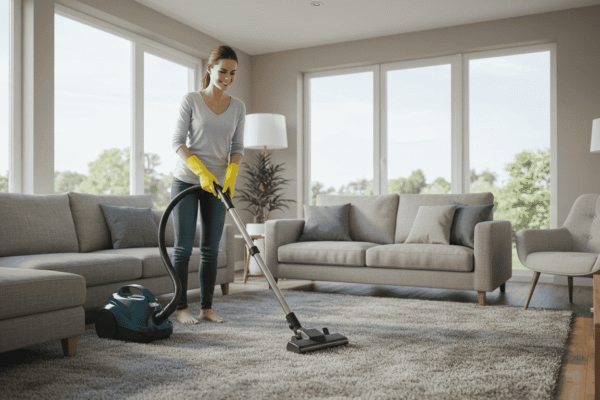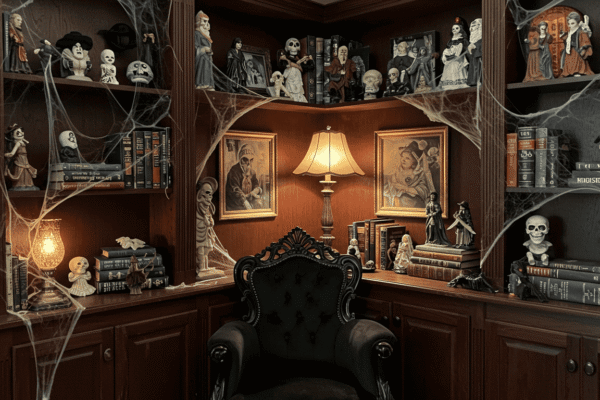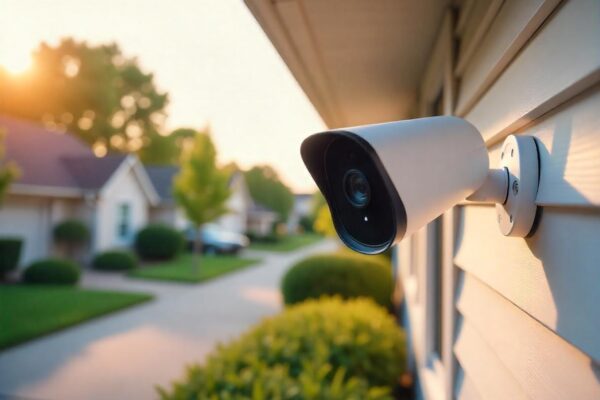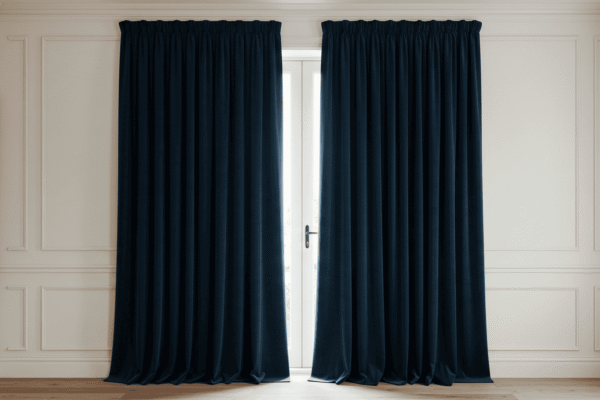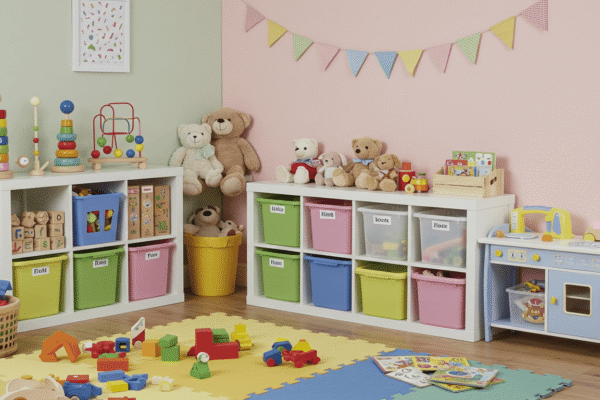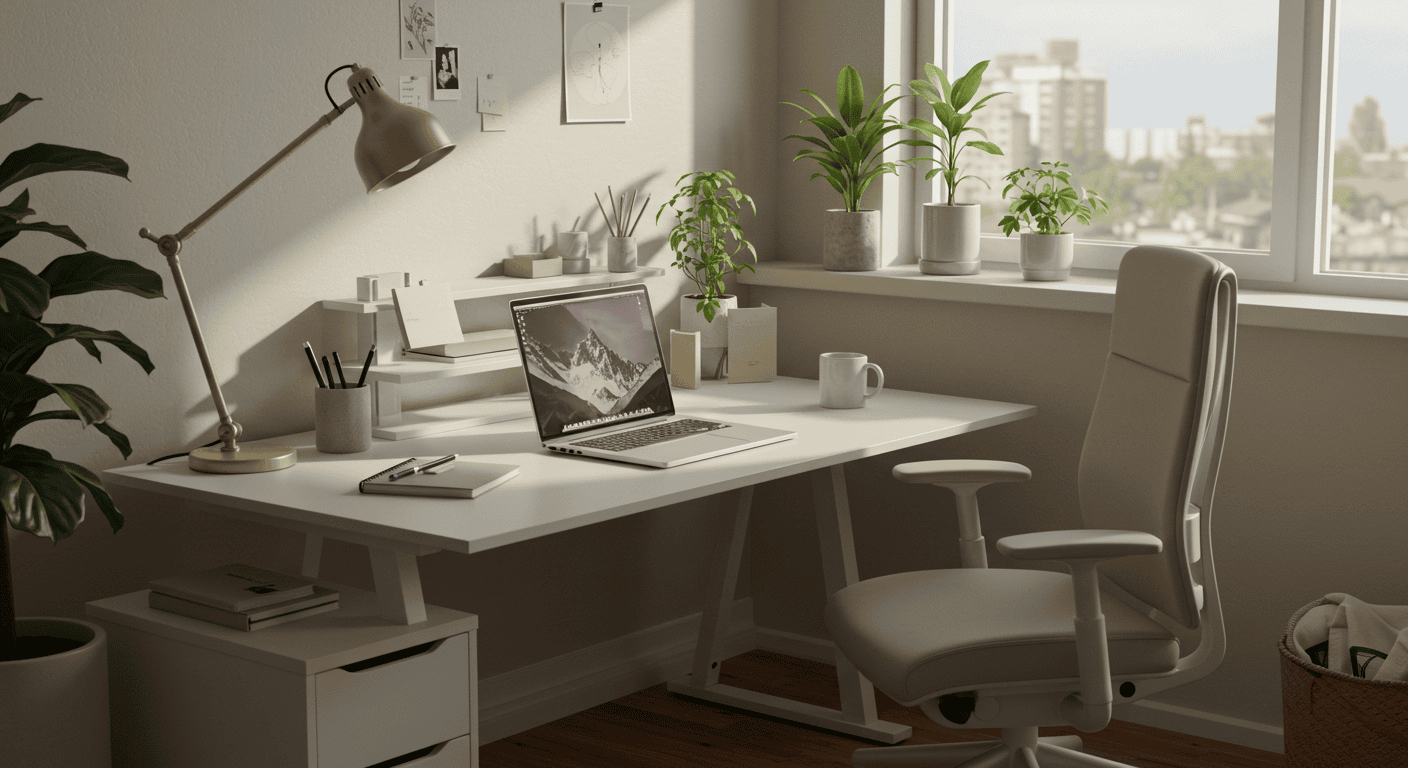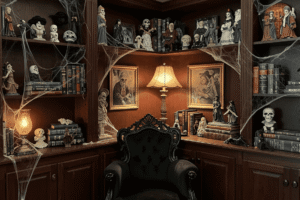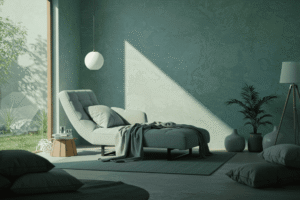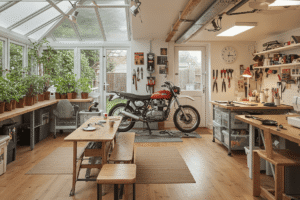How to organize your home office for productivity starts with one simple truth: it doesn’t have to drain your wallet to be effective. In fact, creating a home office on a budget can be both fun and fulfilling—if you approach it with intention and a little creativity. Whether you’re carving out a corner of your bedroom or revamping a spare room, this guide will help you build a workspace that blends functionality, style, and productivity—without overspending. From smart layouts and budget-friendly furniture to clever storage hacks and mood-boosting lighting, we’ll cover everything you need to craft the perfect home office setup that supports your work and well-being.
Start With a Smart Space Audit
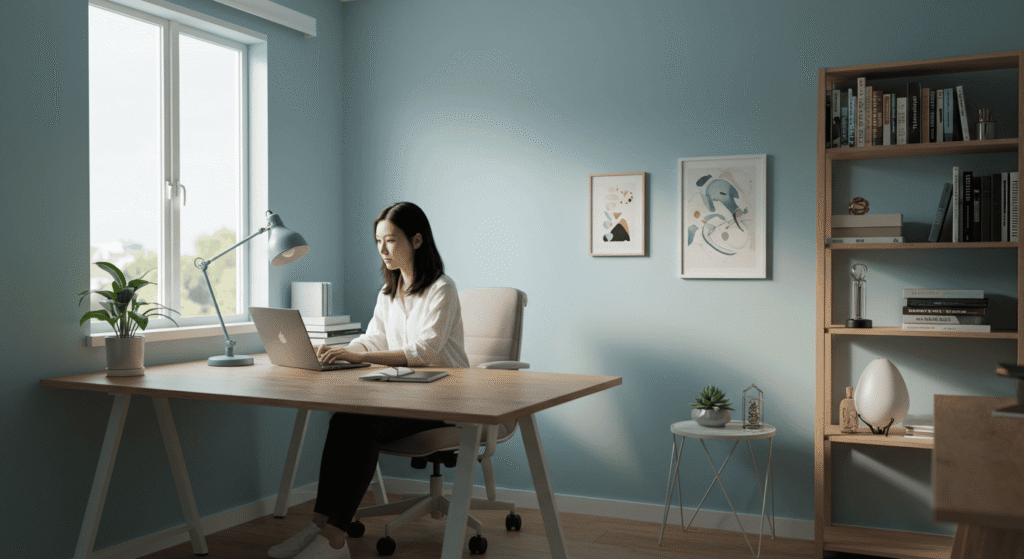
Before diving into decor and furniture, the first step to designing a home office on a budget is understanding what you actually need. A well-thought-out space starts with clarity. Who are you when you work? What kind of tasks fill your day? Where do you focus best? These questions matter more than any fancy chair or trendy shelf. Let’s start by auditing your habits, your environment, and your space to make sure every square meter counts.
Identify Your Workspace Needs
To build the perfect home office setup, start by defining your work style. Are you mostly typing away in silence, hopping from one video call to another, or juggling creative projects that require open surfaces and inspiration boards? Your workspace should reflect your daily workflow—not just look good on Instagram.
Here’s a quick checklist to guide you:
- Do I spend most of my time on video calls or writing?
- Do I need a second screen or just a laptop?
- Do I need a clutter-free space or lots of visual inspiration?
- Will I be sharing this space with someone else?
- Do I need privacy or just a quiet corner?
Being honest about these answers helps you focus your budget on what actually supports your work—whether that’s better lighting, acoustic solutions, or a more comfortable chair.
Find the Right Spot in Your Home
Now that you know what kind of setup you need, it’s time to find the right location. Your home office doesn’t need a separate room, but it does need to support concentration, comfort, and accessibility.
Here’s a quick comparison to help you evaluate your options:
| Feature | Ideal Spot | Not-So-Ideal Spot |
|---|---|---|
| Natural Light | Near a window with indirect sunlight | Dark corners or rooms with no windows |
| Noise Level | Far from kitchen or main living areas | Next to TV or busy hallway |
| Privacy | Has a door or separation | Shared space with high foot traffic |
| Accessibility | Easy to access daily | Cramped or awkward to reach |
| Temperature | Well-ventilated, comfortable climate | Too hot, cold, or drafty |
Choosing the right location is a one-time decision that pays off every day. It sets the foundation for how well your budget-friendly home office design will actually support your goals.
Layout Matters More Than You Think
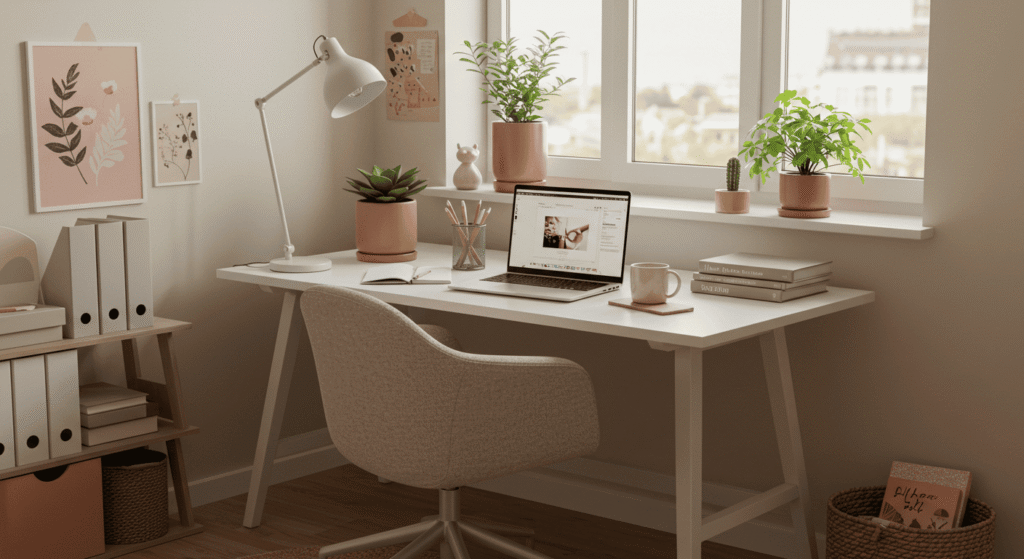
How you arrange your home office can make or break your productivity—especially when working with a limited budget or small space. Thoughtful layout planning helps you make the most of every inch, turning even the tiniest corner into a powerhouse of efficiency and comfort.
Maximize Small Spaces with Purposeful Planning
When space is tight, every piece of furniture and every inch counts. Consider layouts that open up your room instead of crowding it. For example, a corner layout can use often-overlooked spaces effectively. A wall-mounted desk keeps the floor clear and frees up room for movement. Dual-purpose furniture, like a storage bench that doubles as seating, can help reduce clutter without sacrificing style.
Visual Mock-up suggestion:
Imagine a corner desk mounted against two walls, with floating shelves above for supplies and décor. Below, a compact filing cabinet fits neatly under the desk, while a small rolling cart slides out when needed.
Function Over Fancy
While aesthetics are important, your home office design should prioritize function. Create distinct zones that serve different purposes—work, rest, and storage. The work zone is your main desk area optimized for productivity. Nearby, a small comfortable chair or nook can serve as a rest zone, perfect for quick breaks to recharge. Finally, a dedicated storage zone keeps clutter out of sight but easily accessible.
By organizing your space into zones, you can work smarter and stay focused without feeling overwhelmed or cramped. This approach also helps when shopping on a budget, allowing you to invest only in what supports these key functions.
DIY Decor That Doesn’t Look DIY
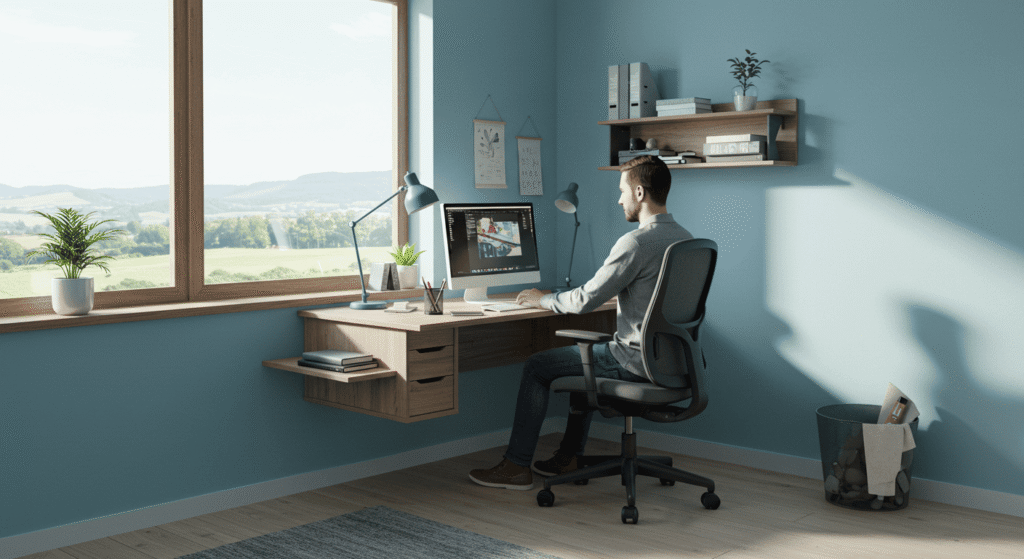
Creating a stylish home office doesn’t mean you have to spend a fortune or rely on store-bought decor. With a bit of creativity, you can transform everyday items into eye-catching, functional pieces that elevate your workspace—without giving off that “DIY project” vibe.
Use What You Already Own (Repurpose Like a Pro)
Look around your home for items that can get a second life in your home office design. For example, stack old books to create a makeshift laptop riser that improves ergonomics. Wooden crates can be mounted on walls or stacked to serve as unique shelving units for supplies and décor. This kind of repurposing not only saves money but adds personality and charm to your space.
Minimalist Style on a Minimal Budget
Visual Breaks with Wall Art, Plants, and Textures
Minimalism is about simplicity—but that doesn’t mean boring. Use small touches like framed prints, a cluster of leafy plants, or varied textures (like a woven rug or linen curtains) to create interest and warmth. These elements provide visual breaks that make your home office feel inviting and balanced.
Neutral Color Palettes That Trick the Eye into Thinking “Clean and Calm”
Stick to soft, neutral tones like warm grays, creams, and muted greens. These colors reflect light well and make your space feel larger and more serene. A neutral palette forms a peaceful backdrop that reduces distractions and enhances focus, all while looking effortlessly chic on any budget.
Budget-Friendly Furniture: Needs vs. Nice-to-Haves
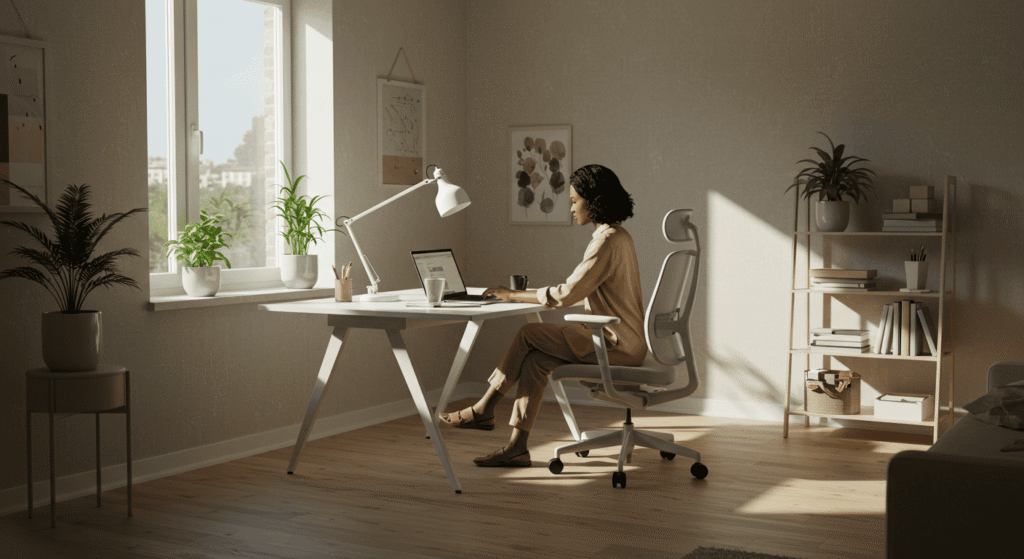
When setting up a home office on a budget, knowing where to spend and where to save is key. Focusing on essentials first ensures your workspace supports your productivity and comfort without draining your wallet on unnecessary extras.
The Essentials That Actually Matter
Here’s a quick guide to the must-have furniture pieces and why they’re crucial for an effective home office design:
| Must-Have | Why It Matters |
|---|---|
| Chair | Supports posture & productivity |
| Desk | Stable workspace, right height |
| Lighting | Prevents fatigue, improves mood |
Investing in these essentials pays off in comfort and efficiency. A good chair prevents back pain, a properly sized desk keeps your work organized, and proper lighting reduces eye strain and boosts focus.
Skip the Luxuries—Here’s What You Don’t Need (Yet)
It’s tempting to fill your office with trendy gadgets and fancy accessories, but those can wait. Adopting a save-now, splurge-later philosophy helps you build a solid foundation first. Prioritize function over flair in the beginning, then upgrade as your budget and needs grow. This approach keeps your workspace practical and your spending smart.
Organization Without the Overwhelm
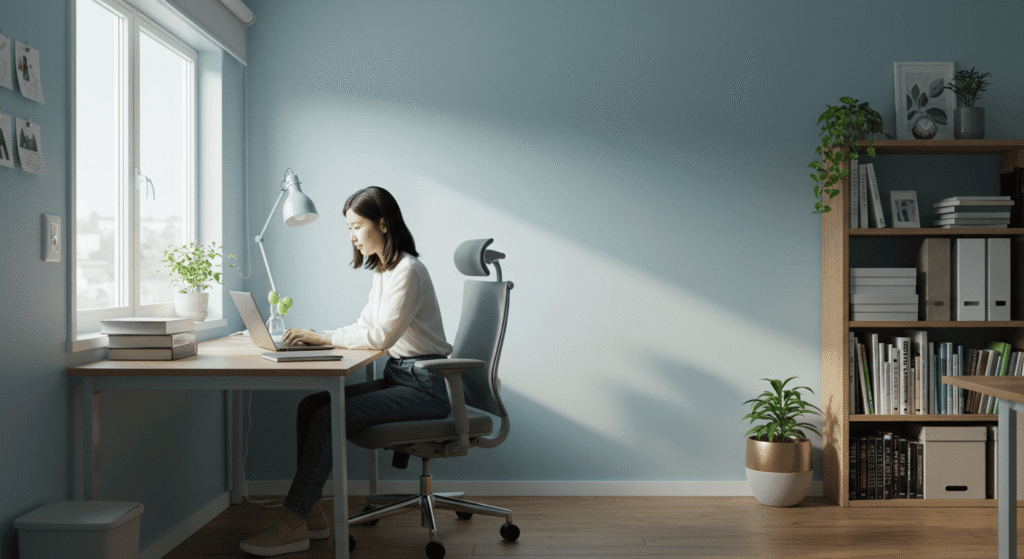
Keeping your home office organized doesn’t have to feel like a full-time job. With simple, budget-friendly solutions, you can tame clutter and create a neat, inspiring space that helps you focus without adding stress.
Cable Chaos? Tame It With These Tricks
Cables are one of the biggest sources of visual clutter in any workspace. Luckily, there are easy ways to keep them under control. Use velcro strips or reusable cable ties to bundle cords neatly. Binder clips can double as cable holders clipped to your desk edge. Hidden trays or boxes placed under or behind your desk keep power strips and chargers out of sight but within reach.
Vertical Storage to the Rescue
When floor space is limited, go vertical. Installing wall shelves creates instant storage without eating up valuable square footage. Pegboards offer customizable organization for tools, supplies, and notes, keeping everything visible and accessible. Hanging organizers, like fabric pockets or small baskets, can be mounted on walls or doors, providing extra storage for smaller items without cluttering your desk.
Lighting: The Unsung Hero of Productivity
Good lighting is often overlooked when designing a home office, but it plays a huge role in how well you focus and feel throughout the day. The right light not only reduces eye strain but also boosts your mood and energy, making your workspace truly supportive.
Let the Sun In (Even If It’s Indirect)
Natural light has a powerful impact on productivity. Exposure to daylight helps regulate your body’s internal clock, improving alertness and reducing fatigue. Even indirect sunlight can brighten your space and create a pleasant, uplifting atmosphere that encourages concentration. Position your desk near a window if possible, but avoid harsh glare that can cause discomfort.
Best Lighting Setups for Late-Night Work
When the sun goes down, your lighting strategy should shift to keep you comfortable without disrupting your focus or sleep cycle. Here’s a simple matrix to guide you through the day:
| Time of Day | Ideal Lighting |
|---|---|
| Morning | Natural + Warm |
| Afternoon | Cool Task Light |
| Night | Dim Ambient + Focus Spot |
Morning light helps gently wake you up, afternoon task lighting keeps you alert, and softer, dimmer lights in the evening reduce blue light exposure while keeping your workspace functional for late-night productivity.
Add Personal Touches Without Wrecking Your Budget
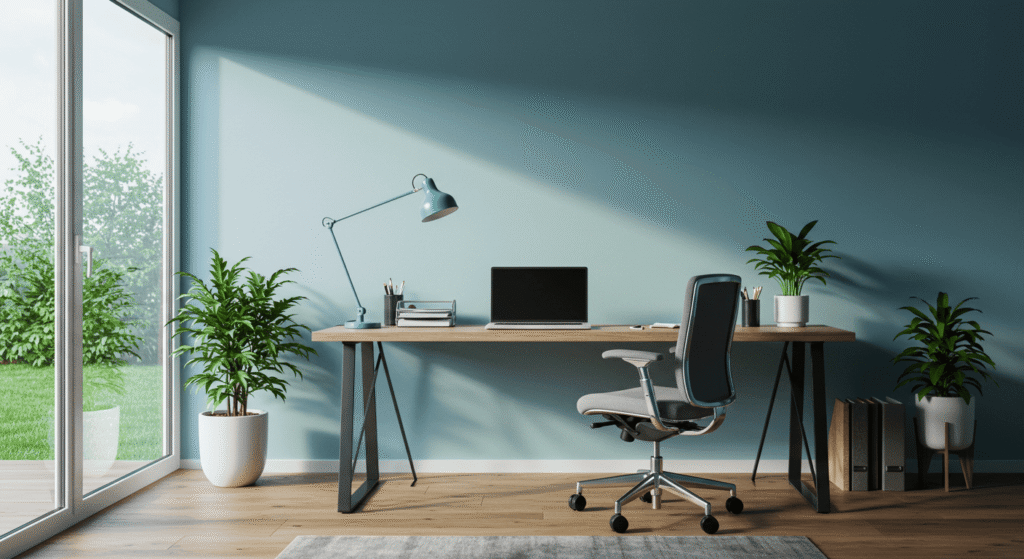
A home office should feel like your own space—a place that inspires and motivates you every day. Adding personal touches doesn’t mean splurging on expensive décor; thoughtful, budget-friendly ideas can make a big impact on how your workspace feels.
Inspire Yourself with Vision Boards or Quote Walls
Create a small vision board or a wall of favorite quotes to keep your goals and motivation front and center. Use simple materials like corkboards, clipboards, or even washi tape to display images, reminders, and inspiring words. This personalized space will help keep you energized and focused during tough workdays.
The Psychology of Color: Pick a Palette That Supports You
Colors influence mood and productivity more than many realize. Choosing the right palette for your home office design can help you feel calm, focused, or energized—depending on what you need.
Infographic suggestion:
A simple visual comparing calming tones (soft blues, greens, muted neutrals) with energizing tones (bright yellows, oranges, bold reds) can help readers decide which colors to incorporate based on their work style and personality. This guide will make it easy to pick colors that support your best work, without overwhelming your budget or your space.
Add Personal Touches Without Wrecking Your Budget
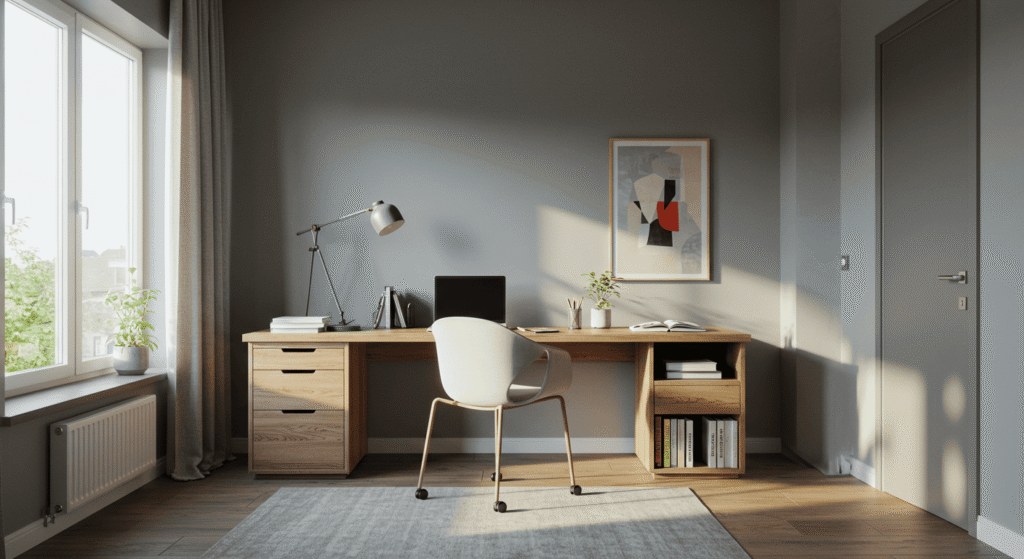
A home office should feel like your own space—a place that inspires and motivates you every day. Adding personal touches doesn’t mean splurging on expensive décor; thoughtful, budget-friendly ideas can make a big impact on how your workspace feels.
Inspire Yourself with Vision Boards or Quote Walls
Create a small vision board or a wall of favorite quotes to keep your goals and motivation front and center. Use simple materials like corkboards, clipboards, or even washi tape to display images, reminders, and inspiring words. This personalized space will help keep you energized and focused during tough workdays.
The Psychology of Color: Pick a Palette That Supports You
Colors influence mood and productivity more than many realize. Choosing the right palette for your home office design can help you feel calm, focused, or energized—depending on what you need.
Here’s a simple color guide to help you decide:
| Color Tone | Effect on Mood | Best For |
|---|---|---|
| Soft Blue | Calming, reduces stress | Focused work, creative tasks |
| Muted Green | Refreshing, balance | Long work hours, relaxation |
| Neutral Beige | Clean, minimalist | Versatile, calming background |
| Bright Yellow | Energizing, uplifting | Brainstorming, motivation |
| Warm Orange | Friendly, stimulating | Social calls, collaborative tasks |
| Bold Red | Exciting, attention-grabbing | High-energy, short tasks |
Selecting colors that suit your personality and work style will help you create a workspace that feels supportive without overwhelming your budget.
Final Tips for Keeping Costs (and Clutter) Low
Designing a home office on a budget means balancing function, style, and spending wisely. To keep both your costs and clutter under control, adopting smart habits will help you maintain a space that works for you without constant upgrades or unnecessary purchases.
The 30-Day Test Rule Before Buying
Before rushing to buy new furniture or gadgets, try the 30-day test rule: wait a full month to see if you genuinely need that item. This pause encourages conscious consumption, helping you avoid impulse buys that add clutter and strain your budget. Often, you’ll find that some items aren’t as essential as they first seemed.
Monthly Check-ins With Your Setup
Regularly reviewing your workspace helps keep it efficient and clutter-free. Use a mini checklist to assess:
- What’s working well in your layout and tools?
- What’s causing frustration or slowing you down?
- What simple, cost-free changes can you make to improve your space?
These check-ins keep your home office optimized as your needs evolve, without adding unnecessary expenses.
FAQ Section (Optional)
Q: How can I make a small home office feel larger?
A: One of the keys to how to organize your home office for productivity in small spaces is using light colors, maximizing natural light, and incorporating vertical storage. These tricks help the area feel more open and efficient.
Q: What’s the best way to organize cables?
A: Use velcro ties, binder clips, and hidden trays to bundle and hide cables neatly.
Q: How important is ergonomic furniture on a budget?
A: When learning how to organize your home office for productivity, ergonomics matter—especially if you’re on a budget. Invest in a supportive chair and ensure your desk is the right height to stay comfortable and avoid fatigue.
Q: Can I mix budget-friendly DIY with professional design?
A: Absolutely! Thoughtful DIY projects combined with strategic purchases create a personalized, functional office without overspending.
How to Organize Your Home Office for Productivity (Without the Stress or the Splurge)
Knowing how to organize your home office for productivity isn’t just about having a tidy desk or a pretty corner—it’s about designing a space that actively helps you do your best work. Whether you’re working full-time from home or simply need a focused area for deep tasks, the right environment can make a big difference in your output, mindset, and even your well-being.
As we’ve explored, organizing your home office for productivity starts with intention. From doing a space audit to understanding your work habits, every decision—from lighting to layout—should serve a purpose. When you’re thoughtful about how your space functions, you naturally reduce distractions and make room for what matters.
You don’t need to overspend to make it happen. In fact, one of the biggest misconceptions about how to organize your home office for productivity is that it requires expensive furniture or professional help. The truth is, with a few creative tricks, DIY ideas, and some well-placed effort, you can build a space that inspires focus and flow—on a budget.
Keep in mind, too, that organizing your home office for productivity isn’t a one-and-done job. Your needs will evolve, so it’s worth revisiting your setup regularly. Check in monthly: what’s working, what isn’t, and what small adjustments could make a big impact?
Ultimately, mastering how to organize your home office for productivity is less about perfection and more about progress. Start with what you have, build intentionally, and let your space evolve as you do. Your most efficient, comfortable, and motivating workspace is closer than you think—and you don’t need to break the bank to create it.

